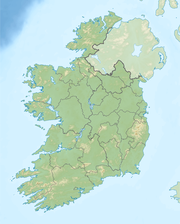Mullaghmore, County Clare
| Mullaghmore | |
|---|---|
| Mullach Mór | |

Mullaghmore hill (right)
|
|
| Highest point | |
| Elevation | 180 m (590 ft) |
| Coordinates | 53°0′28.5402″N 9°0′7.887″W / 53.007927833°N 9.00219083°WCoordinates: 53°0′28.5402″N 9°0′7.887″W / 53.007927833°N 9.00219083°W |
| Geography | |
| Location | County Clare, Republic of Ireland |
| OSI/OSNI grid | R296954 |
| Topo map | OSi Discovery 52 |
| Geology | |
| Mountain type | Sedimentary |
Mullaghmore (Irish: Mullach Mór, meaning "Great Summit") is a 180m limestone hill in the Burren in Glenquin, County Clare, Ireland. It is part of a hiking trail called the Mullaghmore Loop in the Burren National Park.
Throughout the 1990s, a long running conflict about a proposed visitor centre caused "major divisions in the local communities" between those for and against developing a site near Mullaghmore as a visitor center to the Burren.
In April 1991, the Minister of State of the Irish Department of Finance announced a plan for the construction of an interpretative visitors’ centre at Mullaghmore by the Office of Public Works (OPW). This would have made use of EU Regional and Social funds earlier allocated by the European Commission after a general approval of the Irish tourism program that did not, however, take a stand on any specific projects.
The proposal quickly resulted in opposition from a number of groups and individuals. These different groups came together in the Burren Action Group or BAG. They worked out an alternative proposal for a visitor centre. However, there was also a counter-mobilisation by prominent representatives of local communities. These included groups such as the Irish Farmers' Association (IFA), the Gaelic Athletic Association (GAA), as well as politicians from the centre-right. Their coalition became known as Burren National Park Support Association and emphasized the economic potential of the OPW proposal as well as the prospect of much needed jobs in a high unemployment area.
In June 1991, the WWF UK lodged a complaint against the project with the European Commission. It was later joined by An Taisce. They argued that the project would be in violation of Community law regarding the protection of groundwater. In February 1992, OPW published an environmental impact assessment, at the request of the Commission. This, as well as a follow-up study, were criticized by the WWF.
...
Wikipedia

